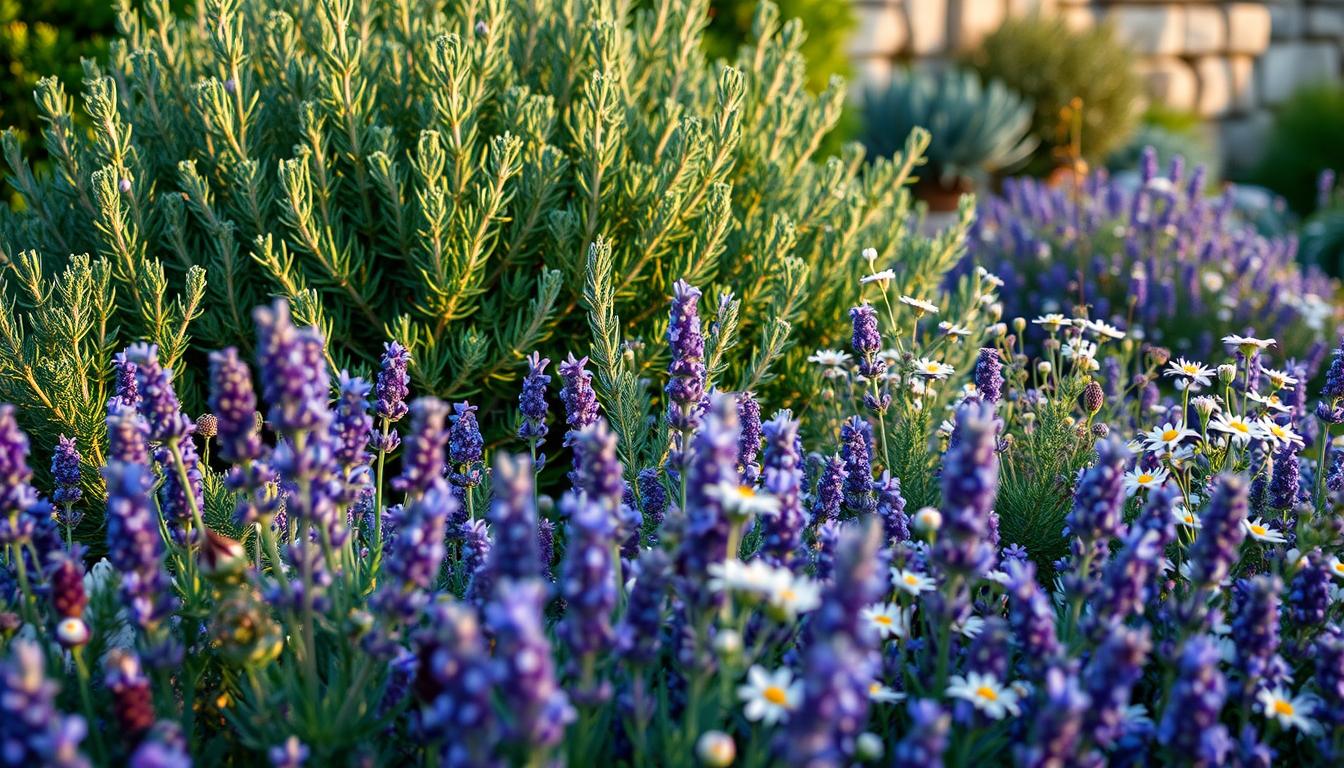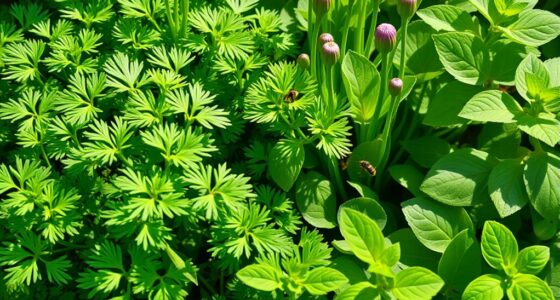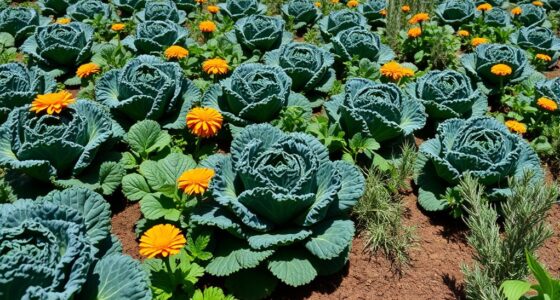Picture yourself strolling through your vibrant garden, breathing in the invigorating scent of rosemary mingled with the sweet aromas of its partner plants. There’s nothing quite like the feeling of nurturing your own oasis—a refuge where nature thrives and your senses come alive. When you embrace companion planting with rosemary, you’re not just growing herbs; you’re cultivating a symphony of flavors, colors, and textures that creates harmony in your outdoor space. Selecting the best companion plants for rosemary is essential, as they not only enhance your garden’s beauty but also promote health by deterring pests and improving growth. Let’s explore the journey of finding the perfect rosemary companion plants that will help your garden flourish.
Key Takeaways
- Companion planting with rosemary boosts growth and flavor.
- Choosing the best companion plants for rosemary can deter pests.
- Rosemary thrives alongside herbs like basil, thyme, and oregano.
- The right partners improve overall garden health and aesthetics.
- Understanding soil and sunlight needs is crucial for successful planting.
Understanding Companion Planting with Rosemary
Companion planting with rosemary is an effective way to enhance your garden’s ecosystem. This practice involves growing different plants together to maximize their mutual benefits. By understanding how various plants interact, you can create a balanced environment that improves both flavor profiles and growth conditions.
What is Companion Planting?
Companion planting refers to the strategic placement of different plant species in proximity to one another. The idea is to take advantage of the natural benefits that they provide, such as pest control, pollination, and enhanced nutrient uptake. Specific combinations can lead to healthier than average plants, as they support each other through various growth stages.
Benefits of Companion Planting
- Increased Flavor: Certain plants enhance the taste of their neighbors. For instance, incorporating rosemary can make nearby vegetables taste even better.
- Pest Control: Some plants naturally repel pests that may harm your rosemary garden partners. For example, strong aromas can deter insects effectively.
- Improved Growth: Plants can provide shade or support for each other, promoting healthier growth conditions.
How Rosemary Fits Into the Picture
Rosemary is a versatile herb that serves multiple roles in companion planting. Its aromatic compounds not only enhance flavor but also deter unwanted pests, making it an ideal partner for many garden companions. Including rosemary in your planting strategy can significantly amplify the overall health and productivity of your garden.
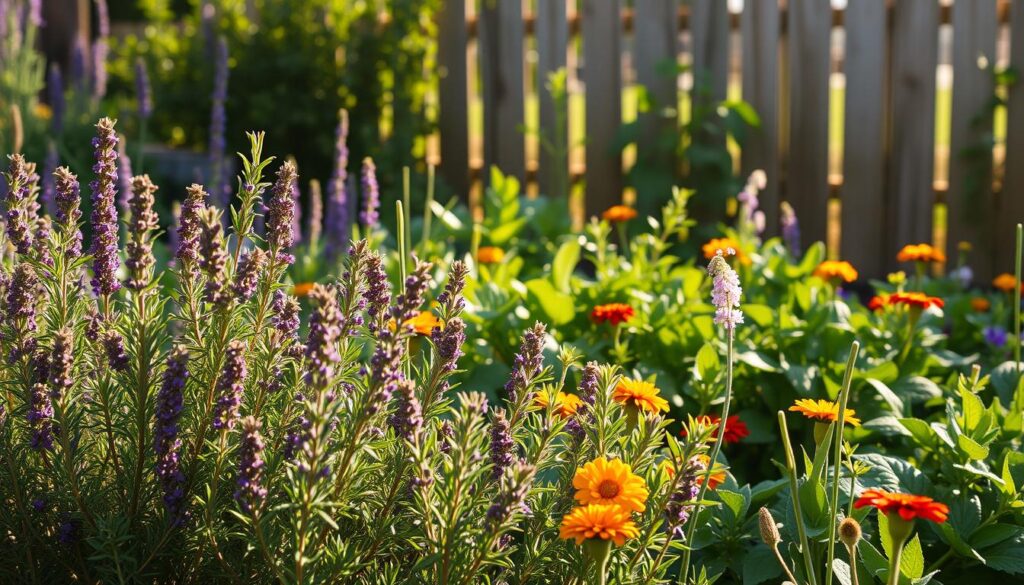
Ideal Conditions for Growing Rosemary
To cultivate a thriving rosemary plant, understanding its specific requirements is essential. This herb flourishes under particular conditions that support its growth and overall health. Emphasizing the ideal conditions for rosemary makes it easier for you to create an optimal environment.
Soil Requirements
The ideal soil for rosemary needs to be well-draining, slightly acidic to neutral with a pH ranging from 6.0 to 7.0. A mix of sandy soil with organic matter enhances drainage while providing essential nutrients. Creating the right rosemary plant requirements helps prevent root rot and promotes healthy growth.
Sunlight and Water Needs
Rosemary thrives in full sunlight, requiring at least six to eight hours of direct sunshine daily. Ensuring adequate sunlight is crucial for optimal growth. As for watering, rosemary prefers a light touch. Watering deeply but infrequently mimics its natural habitat, allowing the soil to dry between watering sessions. This suits its excellent drought tolerance, reinforcing the suitability of these rosemary grow conditions.
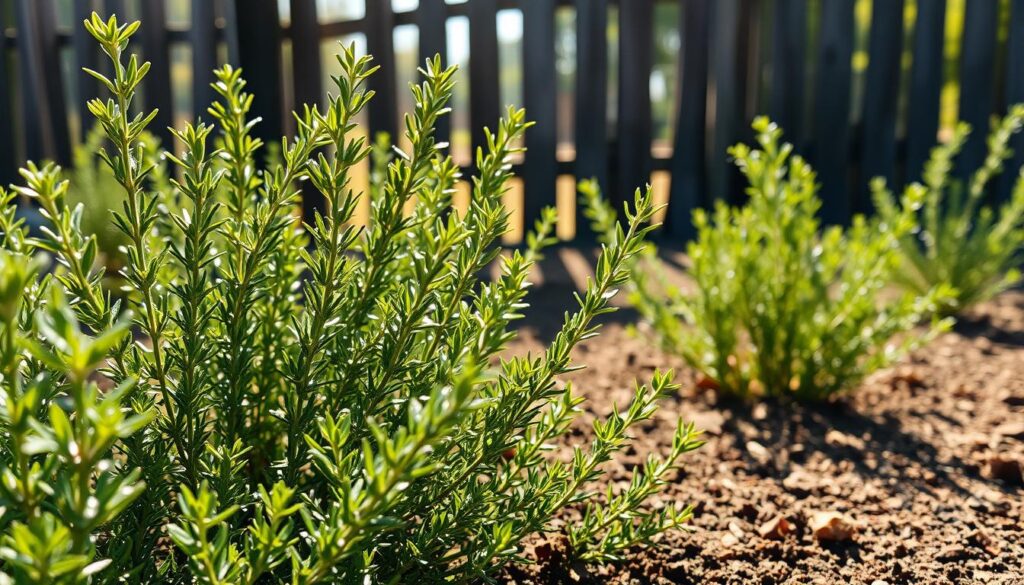
Top Rosemary Companion Plants
Choosing the right plants to grow with rosemary enhances your garden’s overall health and your culinary experience. The top plants to grow with rosemary thrive in similar conditions, helping to create a harmonious garden. In this section, you’ll discover three excellent herbs that grow well with rosemary: basil, thyme, and oregano. Each of these plants shares preferences for sunlight and well-draining soil, making them ideal rosemary plant combinations.
Basil: A Flavorful Partner
Basil complements rosemary beautifully in the garden as well as in the kitchen. These two herbs not only flourish in similar environments but also elevate each other’s flavors in various dishes. When planted together, these herbs can deter pests effectively while providing a rich bounty of aromatic leaves for your culinary creations.
Thyme: An Aromatic Ally
Thyme serves as an aromatic ally to rosemary, sharing the same love for sunny spots and well-drained soil. These herbs that grow well with rosemary benefit from each other’s presence, contributing to a diverse ecosystem that encourages beneficial insects. Together, they thrive, making your garden both fragrant and productive.
Oregano: A Mediterranean Match
Oregano makes a perfect Mediterranean match for rosemary. This herb enjoys the same climatic conditions and can enhance the overall flavor profile of your dishes. Incorporating oregano alongside rosemary not only benefits your cooking but adds diversity to your garden’s biodiversity, ensuring a vibrant and flourishing space.

Companion Plants That Deter Pests
Creating a thriving garden involves choosing the right plants that not only benefit each other but also provide added protection against pests. Certain plants excel as companion plants that deter pests, integrating beautifully with rosemary. These natural pest control plants can help maintain a healthy and balanced ecosystem within your garden. Let’s explore a few of these effective companions.
Nasturtium: A Natural Repellent
Nasturtiums serve as excellent companion plants that deter pests, attracting beneficial insects while warding off harmful ones. The vibrant flowers of nasturtium not only brighten your garden but also serve as a trap for aphids, keeping these pesky invaders away from your rosemary companion plants that repel insects.
Marigold: Bright Flowers, Small Bugs
Marigolds are renowned for their ability to repel common garden pests. By planting marigolds alongside rosemary, you introduce a colorful barrier that actively discourages nematodes and other unwanted insects, creating a healthier environment for your natural pest control plants.
Lavender: Dual Purpose Beauty
Lavender offers a delightful fragrance while attracting pollinators like bees. This aromatic herb also functions as a natural pest deterrent, making it one of the ideal rosemary companion plants that repel insects. The harmonious growth of lavender with rosemary enhances both beauty and pest resistance in your garden.
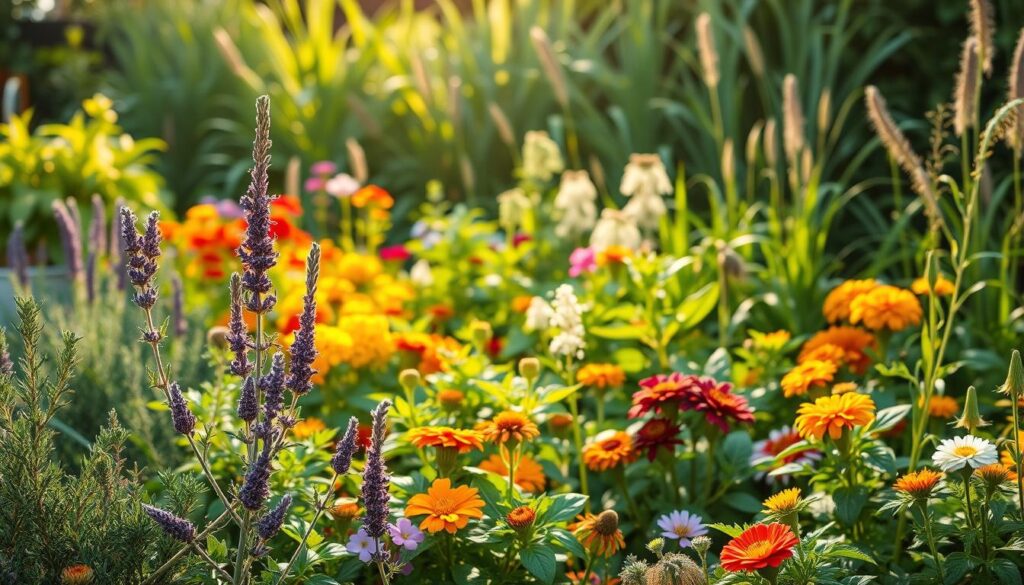
| Plant | Benefits | Pest Deterrence |
|---|---|---|
| Nasturtium | Attracts beneficial insects | Aphids |
| Marigold | Repels nematodes | Common garden pests |
| Lavender | Attracts pollinators | Moths, fleas |
Enhancing Soil Health with Companion Plants
Integrating specific companion plants into your garden can significantly impact the overall vitality of your soil. By incorporating nitrogen-fixing plants alongside rosemary, you can achieve noteworthy soil improvement through companion planting. This approach not only boosts fertilizers but also aids in creating a healthier ecosystem for your garden.
Beans: Nitrogen Fixers
Beans are among the top choices for enriching your garden’s soil. These nitrogen-fixing plants are particularly beneficial as they convert atmospheric nitrogen into a form that plants can use. By planting beans near rosemary, you promote enhancing soil health in a straightforward way. After the beans are harvested, their roots decompose, enriching the soil even further for subsequent plantings.
Carrots: Combining Roots with Herbs
Carrots thrive when planted alongside rosemary, benefiting from the herb’s natural pest-repelling qualities. The combination enhances the chances of survival for carrots by masking their scent. Additionally, this pairing contributes to soil improvement through companion planting. The relationship fosters a healthier soil structure, which ultimately leads to vigorous growth for both crops.
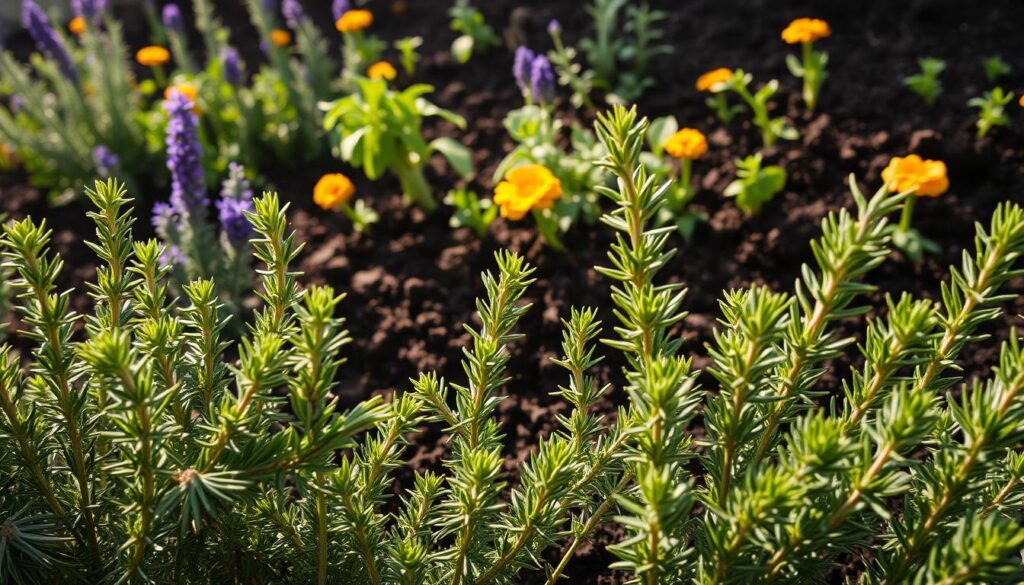
How to Plant Rosemary with Companions
Planting rosemary with companions involves understanding the interrelationship between different plants. Proper companion plant spacing is critical to ensure each plant thrives without competing for resources.
Spacing Considerations
When determining how to plant rosemary with companions, consider the mature size of each plant. Rosemary typically requires more room than smaller herbs. Place rosemary at least 18-24 inches apart to allow for air circulation and growth. Companion plants, particularly those that are shorter, should be positioned around the rosemary to optimize space and light. For instance, herbs like basil and thyme thrive when planted nearby, taking advantage of the sun without overshadowing the rosemary.
Mixing Plant Heights
Creating optimal plant height arrangements enhances a garden’s aesthetics and functionality. Incorporate lower-growing plants like chives or parsley around taller rosemary plants. This arrangement not only maximizes sunlight exposure but also helps maintain soil moisture levels. Additionally, mixing heights allows for easier access during harvesting while minimizing the risk of overcrowding.

Seasonal Tips for Rosemary Planting
Timing plays a crucial role in successfully cultivating rosemary and its companion plants. With the changing seasons come different strategies for planting and caring for these herbs. This guidance will help ensure that you make the most of your seasonal tips for rosemary during both spring and summer.
Spring Planting Strategies
Spring is a prime time for planting rosemary. As the danger of frost passes, you can transplant seedlings or sow seeds directly in the garden. Select a well-drained area that receives plenty of sunlight. When using spring planting strategies, remember to prepare the soil by mixing in compost to enrich its nutrients. This combination promotes healthy root development and sets the stage for vigorous growth throughout the season.
Summer Companion Plant Care
Summer care for rosemary companions focuses on proper watering and maintenance. As temperatures rise, keep the soil consistently moist but not waterlogged. Pruning established plants helps to encourage bushier growth and enhances air circulation. Monitoring pests during summer months is essential; companion plants can assist in deterring unwanted visitors. Implementing these care techniques will promote a thriving garden, allowing you to enjoy your aromatic plants for cooking and garnishing.

| Season | Task | Details |
|---|---|---|
| Spring | Planting | Transplant seedlings and enrich soil with compost. |
| Summer | Watering | Keep soil moist; avoid waterlogging. |
| Summer | Pruning | Encourage bushy growth and improve air circulation. |
Common Mistakes in Companion Planting
Understanding common pitfalls in companion planting is crucial for a thriving garden. You may inadvertently fall into various traps that can hinder the growth and health of your rosemary and its companions. This section highlights frequent errors and offers guidance to help you navigate these challenges effectively.
Overcrowding Issues
One of the most prevalent common companion planting mistakes is overcrowding in gardens. When plants are placed too closely together, they compete for nutrients, light, and water, which results in stunted growth and increased susceptibility to diseases. Proper spacing allows each plant to thrive and reach its full potential. Aim for specific distances between rosemary and its neighbors, following guidelines for each type of companion plant.
Wrong Planting Zones
Choosing the right environment is essential for any plant. Inappropriate planting zones can lead to poor growth or failure altogether. It is vital to identify the suitable planting zones for rosemary, which typically prefer warmer, well-drained areas with plenty of sunlight. Always consider the climate and soil type in your area before deciding where to place your rosemary and its companions.
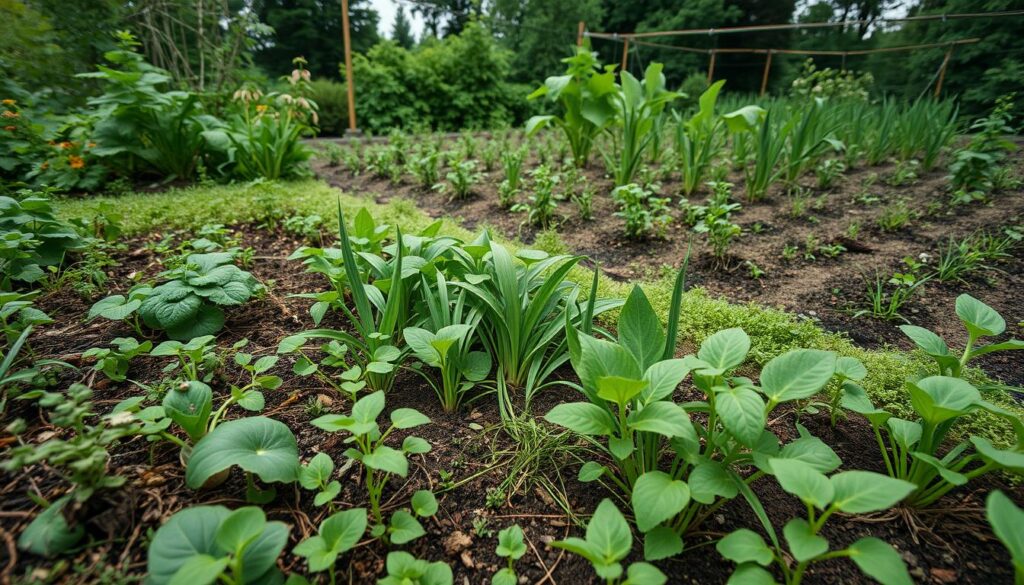
| Common Mistakes | Consequences | Solutions |
|---|---|---|
| Overcrowding | Poor growth, increased disease risk | Maintain recommended spacing |
| Wrong Zones | Stunted growth, plant failure | Research suitable planting zones |
By paying attention to these elements, you can avoid significant setbacks and foster a harmonious environment for your rosemary and its companions. Careful planning lays the groundwork for a flourishing garden that maximizes the benefits of companion planting.
Benefits of Growing Rosemary with Others
Creating a garden with rosemary and its companions offers numerous advantages that enhance both growth and flavor. The benefits of growing rosemary with companions extend beyond mere aesthetics, fostering a richer and more bountiful garden. By selecting the right plants to grow alongside rosemary, you will notice significant flavor enhancement from companion herbs that complement each other beautifully.
Improved Flavor Profiles
The synergy between rosemary and its companion plants creates a complex blend of flavors that elevate your culinary dishes. For instance, pairing rosemary with basil or thyme not only brings out their individual characteristics but also enhances their overall taste. This flavor enhancement from companion herbs allows you to experiment with a variety of dishes, making your meals more vibrant and enjoyable. A diverse herb garden not only satisfies your palate but also enriches your cooking experience.
Increased Pest Resistance
Plant partnerships play a crucial role in building a resilient ecosystem in your garden. The natural properties of specific companion plants, like marigold and lavender, lend pest resistance through plant partnerships with rosemary. These companions repel nuisances like aphids and whiteflies, protecting your rosemary and its neighbors. The combined effects of these plants allow for minimal reliance on synthetic pesticides, promoting a healthier growing environment.
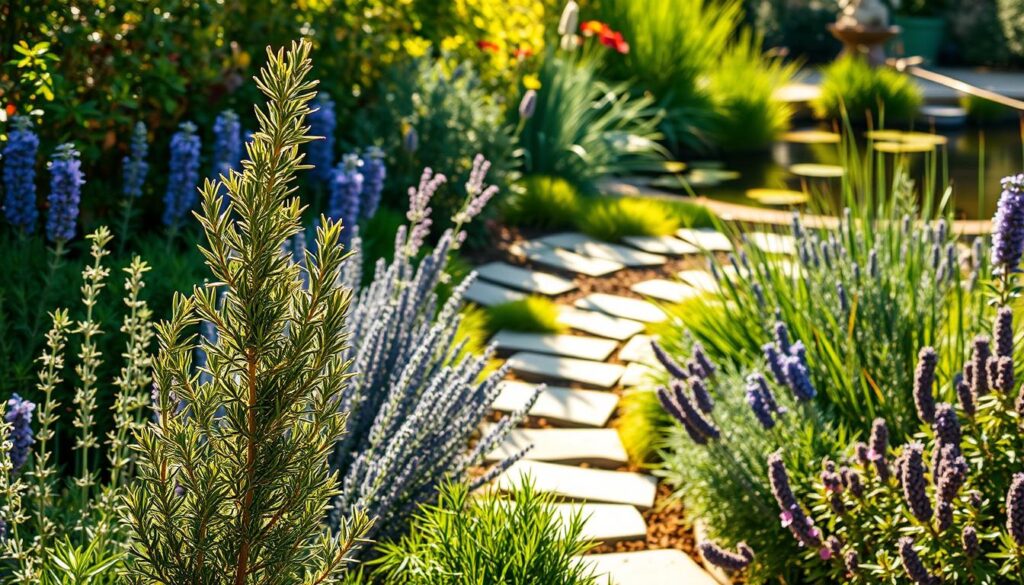
How to Harvest Rosemary and Its Companions
Harvesting rosemary at the right time ensures you gain its full flavor and health benefits. Understanding the best times for herb harvesting and the cutting techniques for fresh herbs will help you maintain a thriving and productive garden. Whether you are a novice or seasoned gardener, knowing these details simplifies the process.
Best Times to Harvest
The ideal times for harvesting rosemary include early morning or late afternoon when the temperatures are cooler. During these periods, you will find that the essential oils are most potent, enhancing the flavor of the herb. Early summer, just before the plant flowers, is often the best time to take your cuttings. This timing applies generally to most herbs, ensuring that you enjoy their richness.
Techniques for Cutting Fresh Herbs
When it comes to harvesting rosemary, utilizing proper cutting techniques makes all the difference for both the plant and you. Use sharp, clean scissors or pruning shears to make clean cuts. Focus on snipping the top few inches of the stems, as this encourages new growth and maintains the overall health of the plant. For your other herb companions, similar techniques can be applied. Remember to cut above leaf nodes to promote future sprouting and greater yields.
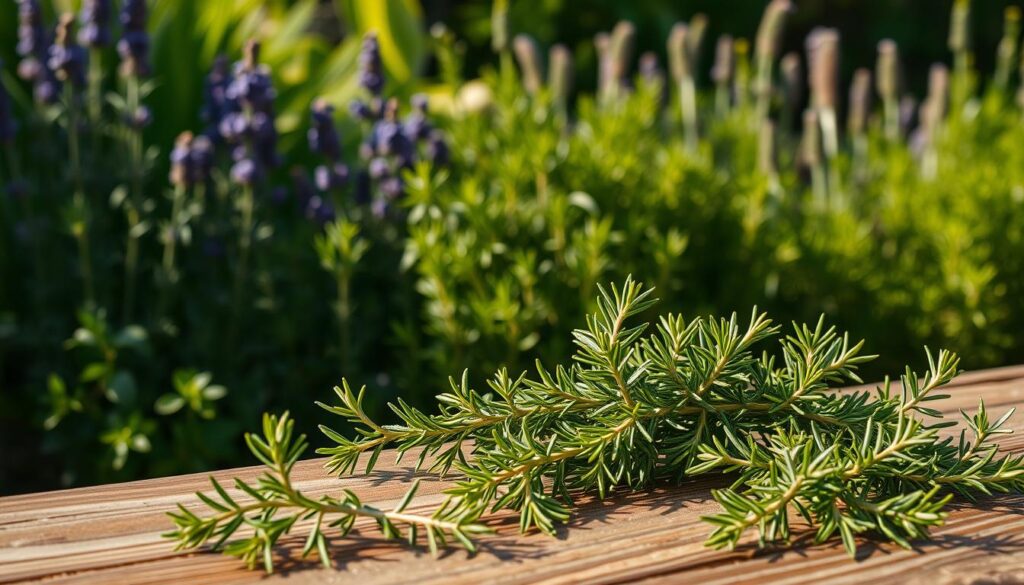
| Herb | Best Time to Harvest | Cutting Technique |
|---|---|---|
| Rosemary | Early morning or late afternoon | Snip above leaf nodes |
| Basil | Early to mid-summer | Cut stems about a third of the way down |
| Thyme | Before flowering | Use scissors to cut sprigs |
| Oregano | Mid-summer | Cut leaves at stem joints |
By understanding the best times for herb harvesting and applying effective cutting techniques, you can significantly enjoy the benefits of fresh herbs from your garden.
Cooking with Rosemary and Its Companions
Cooking with rosemary opens up a world of delicious flavor combinations that enhance your dishes. By pairing this aromatic herb with its companion plants, you can create unique culinary experiences. Discover new ways to incorporate rosemary and its friends into your meals with the following flavor pairings and recipes featuring rosemary companions.
Flavor Pairings
Rosemary pairs beautifully with various ingredients, providing depth and warmth. Consider these standout pairings:
- Rosemary and garlic for a savory touch in roasted meats.
- Rosemary and lemon to brighten up fish dishes.
- Rosemary and olive oil as a marinade for vegetables.
- Rosemary and balsamic vinegar in dressings that elevate salads.
Recipes to Try
Here are some delectable recipes that highlight cooking with rosemary and its companions:
-
Rosemary Lemon Grilled Chicken:
Marinate chicken breasts in olive oil, lemon juice, minced garlic, and chopped rosemary. Grill until cooked through, imparting a fresh and zesty flavor.
-
Roasted Root Vegetables with Rosemary:
Toss carrots, potatoes, and parsnips with olive oil, fresh rosemary, salt, and pepper. Roast until golden and tender for a perfect side dish.
-
Rosemary and Tomato Pasta:
Prepare pasta with a sauce of sautéed garlic, cherry tomatoes, fresh basil, and rosemary for a simple yet flavorful entrée.
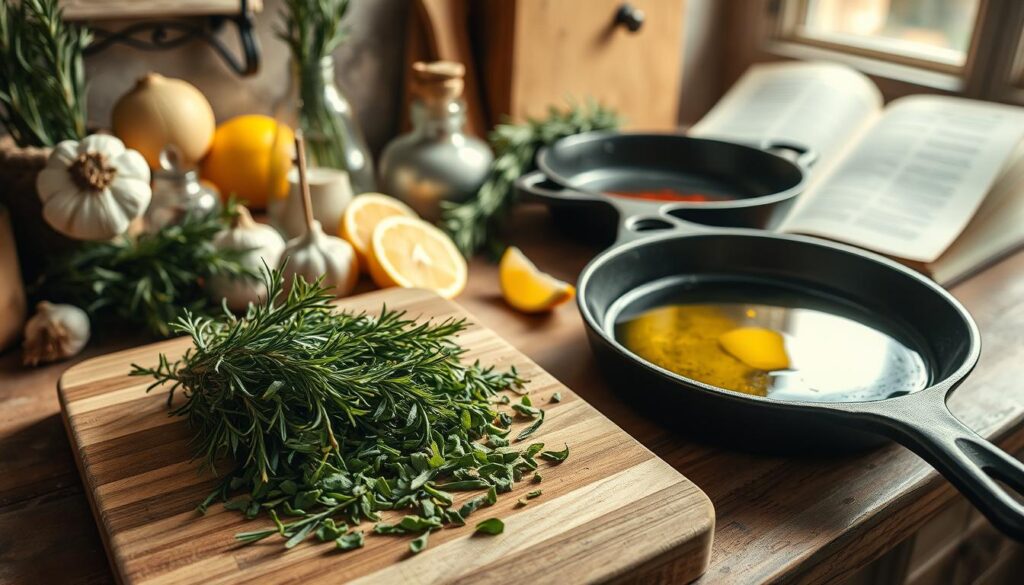
Troubleshooting Rosemary Companion Gardens
Gardening can be a rewarding experience, but challenges often arise when growing rosemary alongside its companions. Understanding how to tackle common issues is essential for maintaining a healthy garden. This section offers insight into identifying plant problems and provides effective strategies for fixing garden issues.
Identifying Problems
One of the first steps in troubleshooting companion gardens is recognizing the signs of distress in your plants. Issues such as yellowing leaves, stunted growth, or discoloration can indicate underlying troubles. You might also notice signs of insect infestations or fungal diseases that typically impact rosemary and its companions.
- Yellowing leaves may suggest overwatering or nutrient deficiencies.
- Pest infestations can often be identified by chewed leaves or visible bugs.
- Stunted growth can indicate poor soil conditions or inadequate light exposure.
Solutions for Common Issues
Once you have pinpointed the problems in your garden, it’s time to explore remedies for these issues. Implementing the right solutions can revitalize your rosemary and its partners, leading to a thriving garden.
- Adjust watering practices: Ensure that you are not overwatering rosemary, as it prefers dry conditions. Check soil moisture regularly.
- Improve soil quality: Enrich your garden beds with organic compost to provide essential nutrients and enhance drainage.
- Combat pests: Use natural pest control methods, such as applying neem oil or introducing beneficial insects to keep pests at bay.
- Enhance sunlight exposure: Place your rosemary in a location that receives at least six hours of direct sunlight daily.
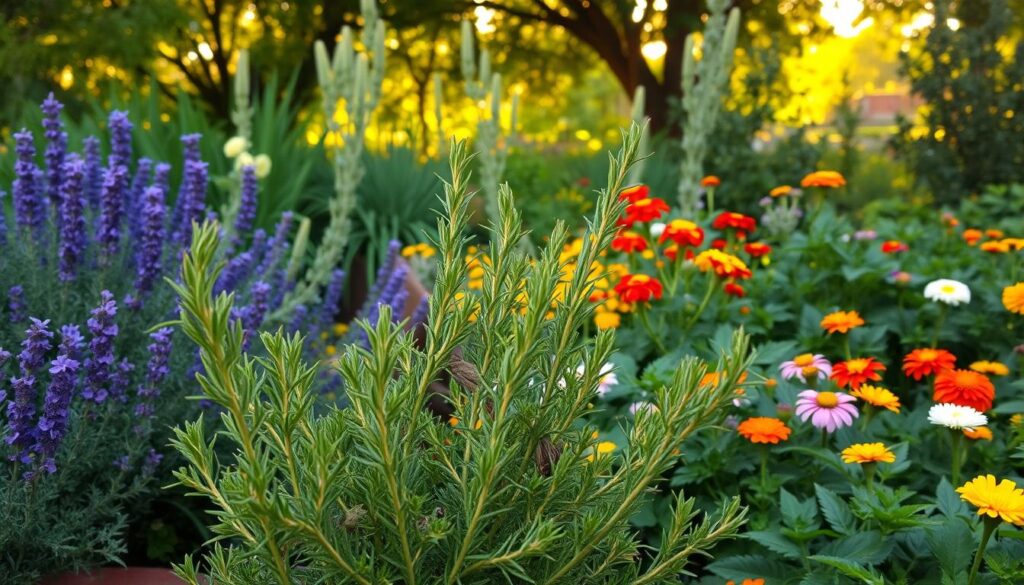
Promoting Pollinators in Your Garden
Creating a garden that attracts and supports pollinators significantly enhances its health and productivity. Incorporating specific plants that attract bees not only helps these vital creatures but also enriches the overall ecosystem. By selecting companion plants alongside rosemary, you can foster an inviting environment for pollinators.
Plants That Attract Bees
Choosing the right plants is essential for promoting pollinators in your garden. Consider including:
- Lavender – Known for its soothing scent, lavender draws in bees and other beneficial insects.
- Sage – This aromatic herb blooms beautifully while serving as an excellent food source for pollinators.
- Sunflowers – Their large floral heads are a beacon for bees, offering ample nectar.
- Echinacea (Coneflower) – This perennial not only captures attention with its vibrant blooms but also attracts a variety of pollinators.

Benefits of Pollinator Presence
The benefits of pollinators in gardens extend beyond mere aesthetics. With pollinators, you can expect:
- Enhanced fruit and vegetable yields due to improved fertilization.
- A healthier ecosystem, as pollinators help in maintaining plant diversity.
- Increased resilience against pests and diseases, fostering a balanced garden environment.
- Longer blooming seasons, as more plants flourish when pollinators are active.
By promoting pollinators, you ensure not only the beauty and productivity of your garden but also contribute to the sustainability of local ecosystems.
Using Rosemary in Your Flower Garden
Integrating rosemary into your flower gardens can significantly elevate your garden’s overall aesthetic. The unique shape and structure of rosemary plants offer a delightful contrast to colorful flowers, enhancing your garden’s visual appeal. You can create stunning designs by considering how rosemary complements various flowering plants, ensuring that your garden flourishes beautifully.
Rosemary’s Visual Appeal
The striking foliage and delicate blue flowers of rosemary catch the eye and add texture to flower beds. Its upright growth habit means it can serve as a backdrop for lower-growing blooms, while the aromatic leaves bring an additional sensory dimension to your garden. The visual appeal of rosemary changes with the seasons, providing year-round interest as the plant matures and flowers.
Design Ideas
When planning your flower garden, consider these design ideas for rosemary:
- Pair rosemary with vibrant annuals like petunias or marigolds to create lively contrasts.
- Utilize rosemary as a border plant, framing your flower beds to define spaces and guide the eye.
- Mix rosemary with ornamental grasses, combining textures for a natural, flowing look.
- Incorporate rosemary into raised beds or containers to enhance the portability and flexibility of your floral displays.
By exploring various combinations, you can maximize the visual appeal of rosemary in flower gardens while creating unique arrangements that reflect your personal style.
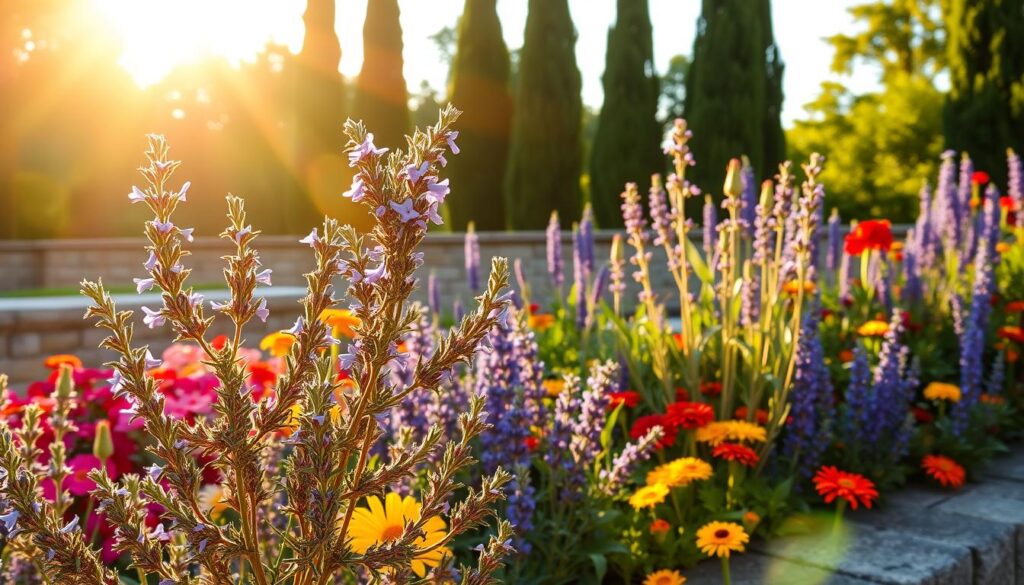
Conclusion: Maximizing Your Rosemary Companion Garden
As you look forward to reaping the benefits of your rosemary companion garden, remember that the journey doesn’t end once you’ve planted your herbs. Maximizing rosemary gardens requires consistent attention, especially when it comes to long-term care for companion plants. Regular maintenance helps ensure that your plants thrive and provide you with bountiful flavors and aromas.
Long-term care for companion plants includes monitoring for pests, ensuring proper watering habits, and knowing when to fertilize. Keep your soil healthy by adding organic matter or mulch, which can help retain moisture and suppress weeds. Additionally, pruning your rosemary and its companions promotes growth and prevents overcrowding, allowing each plant to flourish and yield a generous harvest.
Ultimately, the most rewarding aspect of gardening is enjoying the fruits of your labor. Whether it’s creating delightful dishes with fresh rosemary and its companions or simply basking in the beauty of your flourishing garden, take time to celebrate the vibrant life you’ve cultivated. Cherish each harvest moment and let the flavors of your companions elevate your culinary adventures.
